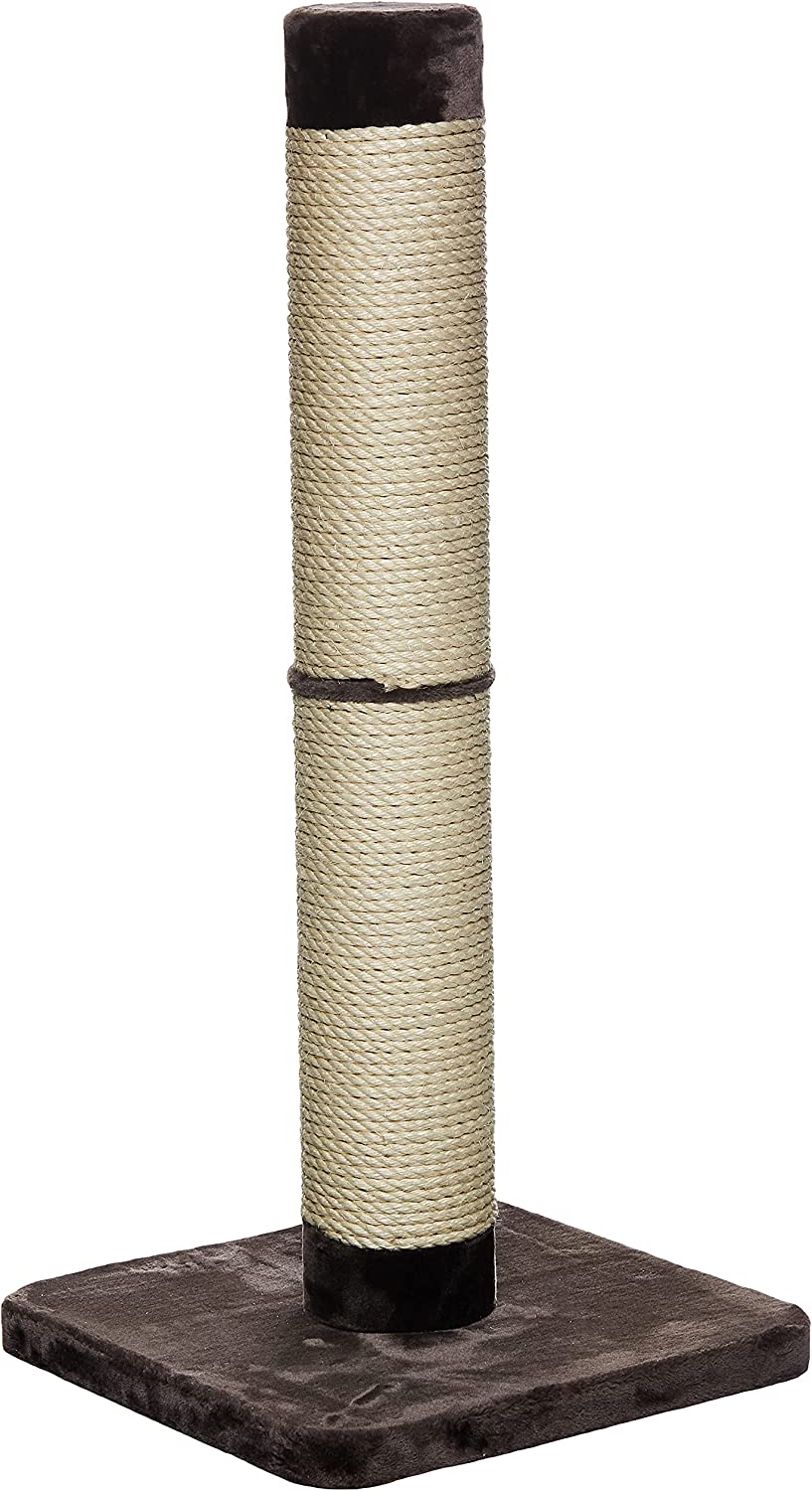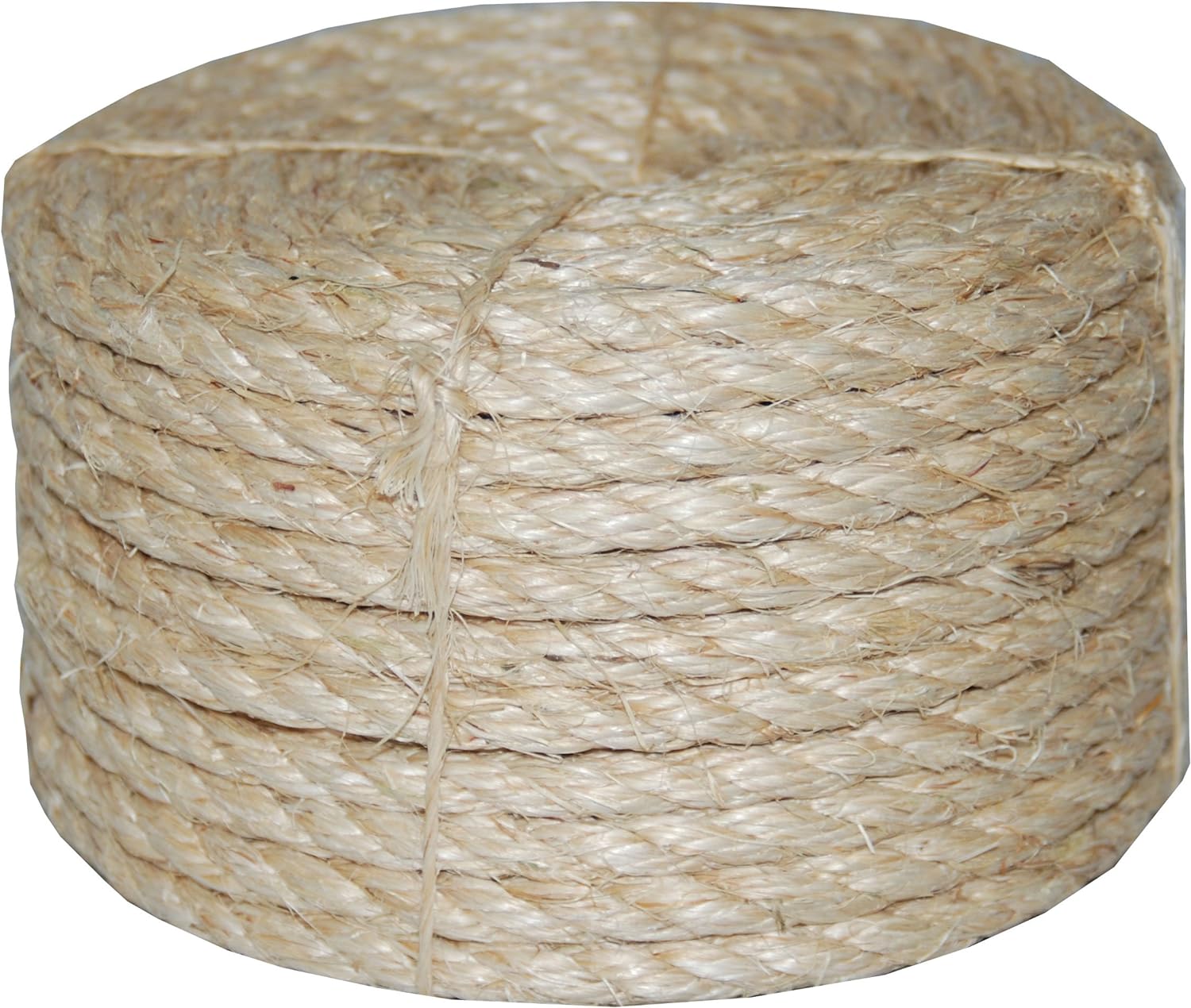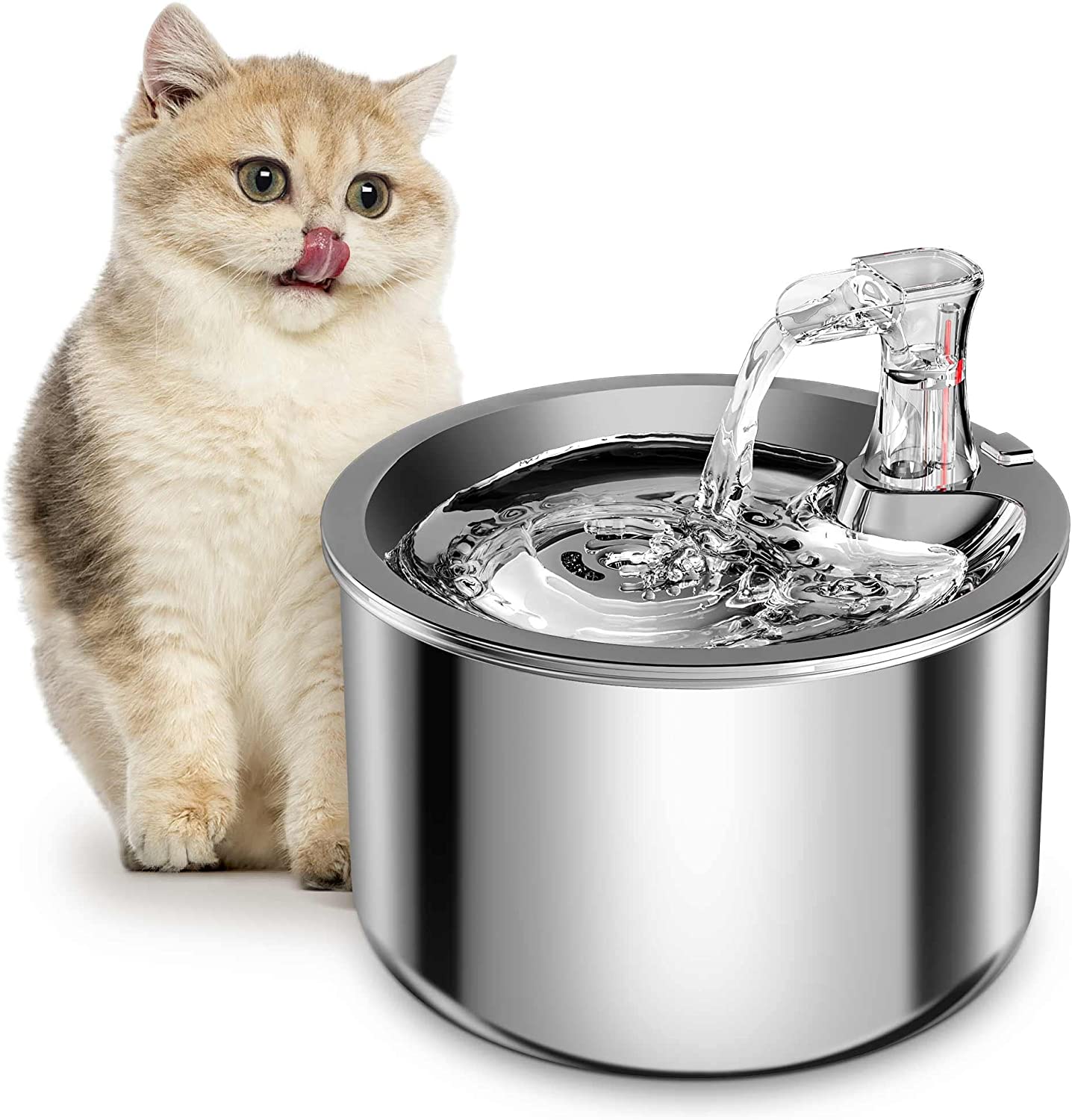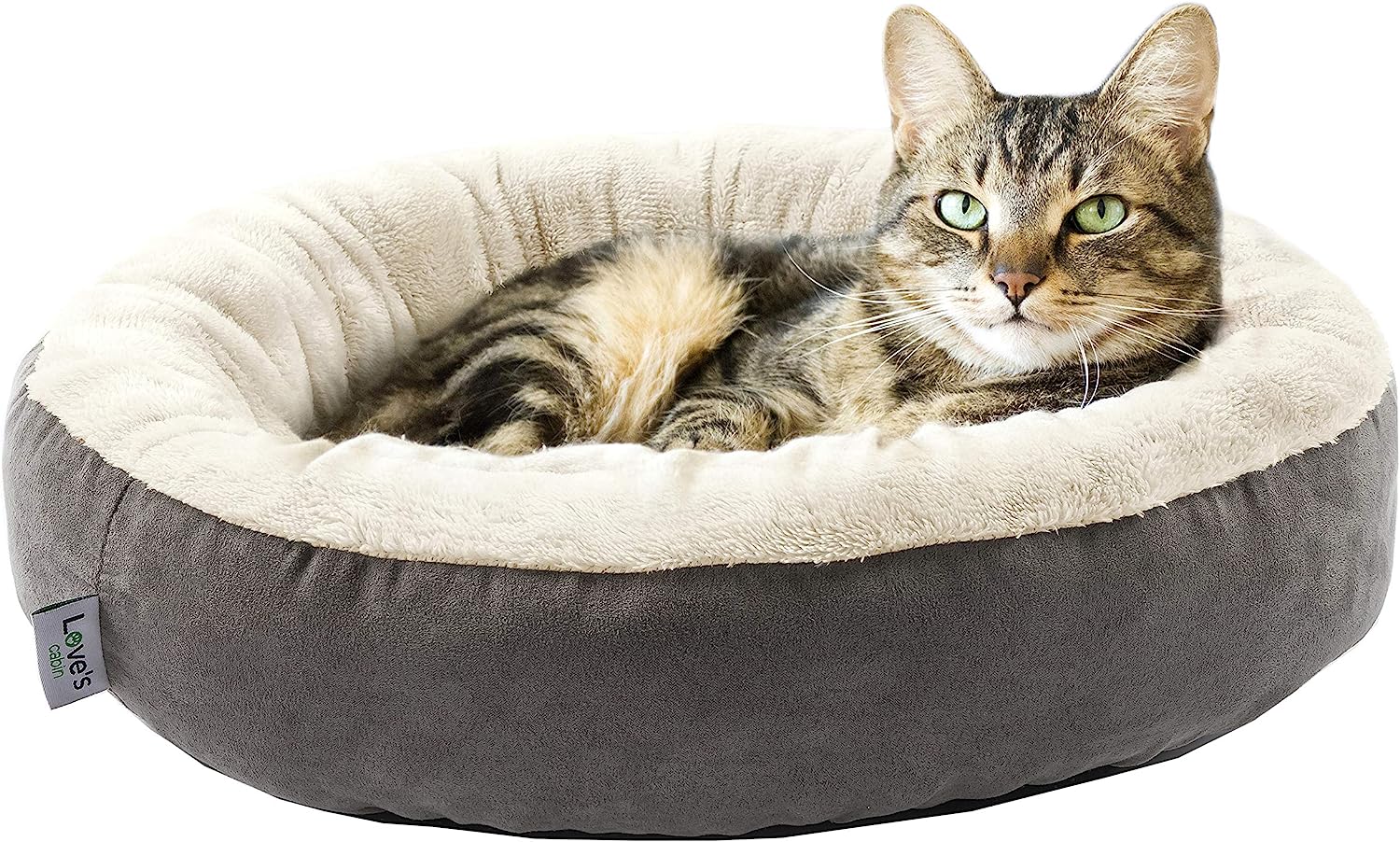iHeartCats is reader-supported. When you buy via links on our site, we may earn an affiliate commission at no extra cost to you.
Welcome to our comprehensive guide on an often-overlooked aspect of feline care: knowing when to replace your cat’s essentials. Whether you’re a seasoned cat parent or new to the world of feline companionship, understanding the lifespan and maintenance of cat accessories is an important part of cat care. From cozy cat beds to exciting cat toys, each item in your cat’s life plays a vital role in their health, happiness, and well-being. That’s why we’re covering all the specifics of when and why to replace key cat items like scratching posts, litter boxes, cat trees, food bowls, water fountains, grooming tools, and even their collars, harnesses, and leashes. These essentials aren’t just everyday items but integral parts of your cat’s daily routine and comfort.
We’ll explore tell-tale signs of wear and tear, the importance of timely replacement for safety and hygiene, and tips for choosing the right replacements. Plus, we’ll touch on the nuances of maintaining these items to extend their life and ensure your cat’s satisfaction. Join us as we guide you through caring for your cat’s stuff!
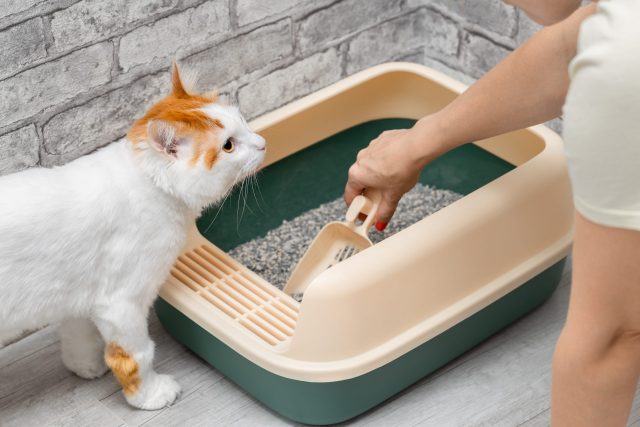
When should I replace cat litter boxes?
A clean and comfortable litter box is an important part of your cat’s health and happiness. Over time, even the best-maintained litter boxes need to be replaced. Understanding when and how to replace old litter boxes, along with the litter itself, can significantly impact your cat’s well-being and your home’s cleanliness.
When to Replace a Cat Litter Box
#1 – Age of the Litter Box:
Generally, a litter box should be replaced every year. However, this can vary based on the material of the box, how well it is maintained, and how many cats are using it. Even if it’s not one of the more popular litter pans in the house, replacing it after a couple of years’ use is still a good idea.
#2 – Signs of Wear and Tear:
Cat claws and the movement of litter over surfaces can abrade litter pans over time. Look for visible cracks, chips, or deep scratches. These imperfections can harbor harmful bacteria and make the box difficult to clean thoroughly.
#3 – Persistent Odors:
Plastic litter boxes can absorb odors over time. If you notice a lingering smell despite regular cleaning, it’s a sign that the box needs replacing. Those hard-to-banish smells can upset your cat’s delicate sense of smell and send them running from an old litter box.
RELATED: 10 Natural Ways To Clean The Litter Box
#4 – Changes in Your Cat’s Preference or Size:
If your cat seems reluctant to use the box or has grown significantly, it might be time for a new one that better suits their size and preference.
Choosing the Right Replacement
- Size and Style: Make sure the new box is large enough for your cat to turn around comfortably. Covered boxes offer privacy but might not be preferred by all cats.
- Material: High-quality, durable materials can extend the life of a litter box. Some cat owners prefer more sustainable options like biodegradable boxes.
- Ease of Cleaning: Consider features that make cleaning easier, such as non-stick coatings or litter boxes with removable trays.
- Read Reviews: If it’s time to replace the pan, check out The 11 Best Cat Litter Boxes For The Purrfect Potty Experience!
Replacing Cat Litter
In addition to the box itself, the litter needs regular replacement and maintenance:
- Scooping Frequency: Remove clumps and solid waste from the litter daily.
- Complete Change: Depending on the type of litter used, a complete change should be done every 2-4 weeks to ensure cleanliness and odor control.
- Types of Litter: Explore different types of litter (clumping, non-clumping, crystal, biodegradable) to find the one that works best for your cat and your cleaning routine.
- Transitioning Litter Types: If you decide to change the type of litter, do it gradually to allow your cat to adjust to the new texture and smell.
Regularly replacing your cat’s litter box and litter is vital for their health and your home’s hygiene. Remember, a well-maintained litter box is key to preventing behavioral issues and promoting a happy, healthy cat.
RELATED: 25 Cat Litter Box Questions: Find Answers To Your Queries About The Potty Pan

When should I replace scratching posts?
Scratching is a natural and essential behavior for cats, helping them to keep their claws healthy, mark their territory, and stretch their muscles. Therefore, providing a sturdy and appealing scratching post is important for your cat’s well-being and your furniture’s. But how do you know when it’s time to replace or rewrap a scratching post? There’s really no set timeframe, as cats have different preferences, and one kitty may wear a post out before another. It’s really about identifying the signs that it’s time to replace the scratching post.
Signs It’s Time for Replacement
#1 – Visible Wear and Tear:
The most obvious sign is significant fraying or wear. If the scratching post looks shredded or the material is coming apart, it’s time for a replacement. Cats might lose interest in a post that no longer provides the necessary resistance for a good scratch.
#2 – Stability Issues:
A wobbly or unstable scratching post can be dangerous for your cat. If the base or the post itself cannot be tightened or repaired, it’s safer to replace it. Get your kitty MidWest Homes for Pets Forte Cat Scratching Post as a replacement. They’ll love the 42-inches of post that lets them fully stretch out for a good scratch.
Sometimes, a scratching post can be salvaged through rewrapping rather than fully replaced. If the post’s construction is still sturdy, opt for replacing the frayed scratching medium as a cost-effective option. Sisal rope and fabric are popular choices for rewrapping. They are durable and provide a good texture for cats to scratch. Pick up a roll of T.W . Evans Cordage Co. Twisted Sisal Rope to freshen up your kitty’s post.
Rewrapping a scratching post can be a rewarding DIY project. Ensure the new material is securely attached to the post and does not have any loose ends that could be ingested by your cat.
#3 – Permanent Odors and Stains:
Cats often leave scent markers on their scratching posts. Over time, these can lead to unpleasant odors and stains that are difficult to remove. A post that no longer smells or looks clean despite your best efforts should be replaced.
#4 – Size Matters:
As kittens grow, they might outgrow their initial scratching post. If your cat can no longer comfortably stretch out while using the post, it’s time for an upgrade.
Regularly inspecting your cat’s scratching post is essential. A well-maintained scratching post is more than just a tool for claw maintenance; it’s a significant part of your cat’s daily routine and happiness.
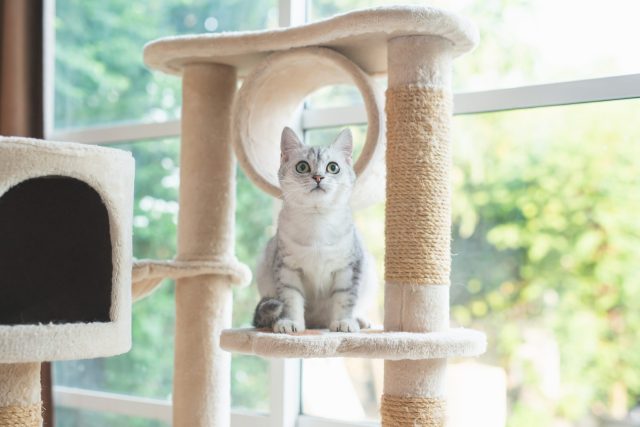
When should I replace the cat tree?
Cat trees and towers are more than just playthings; they’re essential for your cat’s physical activity, mental stimulation, and comfort. Over time, these structures can wear out, potentially becoming unsafe or unattractive to your cat. Recognizing when it’s time to replace them is key to maintaining your cat’s health and happiness. Here’s what you need to know:
Signs It’s Time to Replace a Cat Tree
- Visible Wear and Tear: Look for signs of significant damage, such as frayed rope, torn fabric, or exposed wood. These can indicate that the tree or tower is no longer safe or enjoyable for your cat.
- Stability Issues: A wobbly or unstable cat tree poses a risk of injury. If tightening screws or reinforcing the base doesn’t help, it’s time for a new one.
- Lack of Interest: If your cat is no longer using the tree as much as they used to, it could be due to discomfort from the wear and tear. A new tree might rekindle their interest.
- Size and Age of Your Cat: As kittens grow or cats age, their needs change. A tree that was suitable for a kitten might not be ideal for an adult cat, and older cats might prefer something with easier access.
Choosing the Right Replacement
#1 – Sturdiness and Safety:
The new cat tree should be sturdy and able to support your cat’s weight without tipping. Look for a well-balanced base and robust construction.
#2 – Appropriate Size:
Cat towers are built in all sizes and shapes, and it can be easy to accidentally purchase one that’s too small for your cat. Advertising pictures can be deceptive! Measure your old tower and compare measurements to ensure the new one is tall enough for climbing and has adequately sized perches and platforms for your cat to lounge on comfortably.
#3 – Material Considerations:
Choose materials that are durable and easy to clean. Natural materials like solid wood and sisal rope are often more durable than cheaper alternatives.
#4 – Features:
Consider trees with multiple levels, scratching posts, and hideaways. The more features a tree has, the more it can cater to your cat’s needs for play, scratching, and relaxation. And the Armarkat 72-Inch Cat Tree offers so much activity your kitty will feel like they’ve climbed into feline heaven.
Disposing of the Old Cat Tree
When replacing an old cat tree, consider environmentally friendly disposal methods. Some parts, like sisal rope or untreated wood, might be recyclable. Alternatively, you could donate it to a local animal shelter or offer it for free online if it’s still safe to use but no longer suits your cat.
A well-chosen cat tree or tower can significantly enrich your cat’s life, providing them with a space for exercise, relaxation, and scratching. Keeping an eye on the condition of your cat’s tree and replacing it when necessary ensures your feline friend stays engaged and safe.
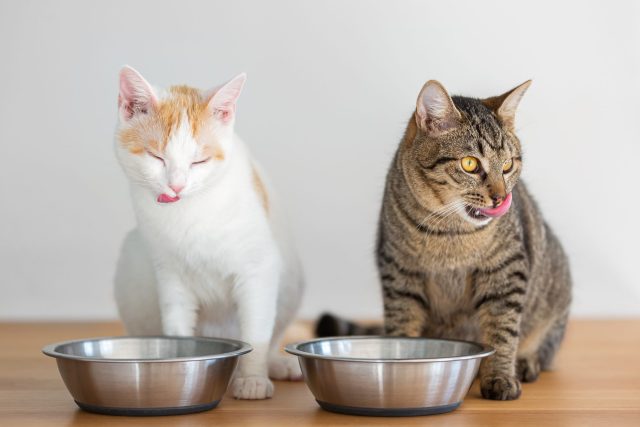
When should I replace cat food bowls? Water bowls?
The humble cat food bowl and water bowl play a pivotal role in your cat’s daily routine. They’re not just vessels for food and water; their condition can significantly impact your cat’s health. Regular replacement and proper maintenance of these bowls are part of good cat parenting. Here’s a guide on when and why to replace cat food bowls and what to consider when selecting new ones.
When to Replace Cat Bowls
- Visible Wear and Tear: Scratches, chips, or cracks in the bowls can harbor harmful bacteria and make them difficult to clean effectively.
- Material Degradation: Plastic bowls, in particular, can degrade over time, potentially releasing harmful chemicals and retaining odors. Cheap plastic can also be a source of feline acne.
- Changes in Your Cat’s Needs: As cats age, they might benefit from bowls of different heights or sizes. For example, raised bowls can help older cats or those with digestive issues eat more comfortably.
- Persistent Odors: If you notice a lingering smell despite regular washing, replace that nasty bowl!
Choosing the Right Replacement
- Material Considerations: Stainless steel, ceramic, or glass bowls are generally recommended over plastic. They are more durable, easier to clean, and less likely to harbor bacteria.
- Size and Depth: Ensure the bowls are the right size for your cat’s food portions and deep enough to prevent spilling but not too deep to cause discomfort while eating.
- Design for Comfort: Consider ergonomic designs, such as tilted or raised bowls, which can help reduce neck strain and improve digestion. Wider bowls accommodate whiskers, helping to reduce whisker fatigue.
- Non-Slip Features: Bowls with non-slip bases are ideal for preventing sliding and spilling during meals.
Hygiene and Maintenance
Regular cleaning is vital for any cat food bowl. Wash the bowls daily with hot, soapy water and rinse thoroughly. If you use a dishwasher, make sure the bowls are dishwasher-safe. And always remember, a clean and suitable bowl can make meal times more enjoyable and safe for your feline friend.
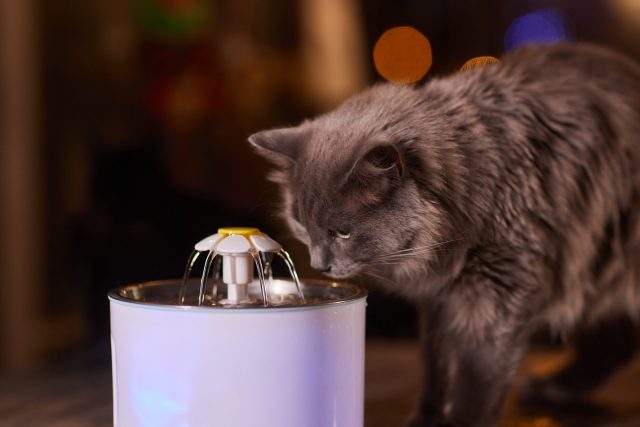
When should I replace a cat water fountains?
A cat water fountain is an excellent way to ensure your feline friend stays hydrated with a constant supply of fresh water. However, like any other cat accessory, it requires regular maintenance and eventual replacement. Knowing when to replace a cat water fountain can be tricky, though. They’re typically made to last a long while, but over time, you may notice your cat’s fountain just won’t stay clean. Here’s a guide to help you determine when it’s time for a new water fountain and what to look for in a replacement.
RELATED: 10 Reasons Cats Don’t Like Drinking Out Of Water Bowls
Signs It’s Time To Replace a Cat Water Fountain
- Persistent Biofilm Buildup: If you notice a slimy substance on the surfaces of the fountain that’s hard to clean, it’s a biofilm. Persistent biofilm buildup can be a breeding ground for bacteria and indicates it’s time to replace the fountain when regular cleaning won’t stay ahead of it.
- Motor or Pump Failure: If the fountain’s motor or pump becomes noisy, works intermittently, or stops working altogether despite proper cleaning and maintenance, consider replacing the unit. Replacement pumps can be found online if the rest of the fountain is still in good condition.
- Visible Wear and Tear: Cracks, chips, or other damages to the fountain can not only lead to leaks but may also harbor harmful bacteria. Replace damaged fountains.
- Changes in Water Flow or Quality: A noticeable decrease in water flow or changes in water quality despite regular filter changes can signify that the fountain is nearing the end of its lifespan.
- Material Degradation: Over time, materials like plastic can degrade, especially if exposed to sunlight or cleaned with harsh chemicals, making the fountain less safe for your cat.
Choosing the Right Replacement
- Material Quality: Opt for fountains made from hygienic materials like stainless steel or ceramic, as they are more durable and less prone to biofilm formation than plastic.
- Ease of Cleaning: Look for a design that’s easy to disassemble and clean. Regular cleaning is essential for maintaining water quality and fountain longevity.
- Quiet Operation: A good water fountain should operate quietly. Excessive noise can deter cats from drinking water.
- Appropriate Size: Consider the size of the fountain based on the number of cats you have. A larger capacity is better for multiple cats.
- Filter Quality: Ensure the replacement fountain has a high-quality filter system to keep the water fresh and clean.
The PETLIBRO Cat Water Fountain Stainless Steel checks all these boxes with a durable hydration experience that’s easy to refill and clean. A filter and pre-filter sponge provide double filtration to remove odors, hair, and debris. The lid lifts off and replaces easily for adding water. To turn it on/off, simply plug and unplug from wall outlet. Plus, in reading reviews, you’ll find this is one of the best-rated cat water fountains on Amazon.
Regular Maintenance
To extend the lifespan of your cat water fountain, regular maintenance is key. This includes cleaning the fountain weekly, replacing filters as recommended by the manufacturer, and monitoring the water pump and motor for any signs of wear. Also, don’t forget to take apart the water pump and clean all the little parts.

When should I replace my cat’s bed?
A comfortable and clean bed makes for a happy cat, but over time, cat beds can wear out, lose their comfort, and become a haven for allergens and bacteria. Here’s when to consider replacing your cat’s bed and what to look for in a new one.
Signs It’s Time to Replace Cat Beds
- Visible Wear and Tear: Look for signs of damage like tears, holes, or significant fraying. These can compromise the bed’s comfort and safety.
- Persistent Odors and Stains: If odors and stains remain despite washing, it’s time for a new bed. Persistent smells can be unpleasant for both you and your cat.
- Loss of Shape or Support: If the bed has become lumpy or lost its shape, it may no longer provide the necessary support for your cat’s joints.
- Changes in Your Cat’s Needs: As cats age, they may require beds with more cushioning or easier accessibility.
Choosing the Right Replacement Cat Bed
Opt for durable, easy-to-clean materials. Removable and washable covers are a plus. Ensure the bed is the right size for your cat to stretch out comfortably. For senior cats, beds with lower sides or orthopedic beds can be a win. And don’t forget style! Consider where your cat’s new bed will be placed, and choose a look that complements your home decor. An option like the Love’s Cabin Round Donut Cat Cushion Bed provides a plush haven of luxurious faux fur while complimenting any home aesthetic. It’s available in various colors and sizes to suit any kitty and style.
RELATED: 11 Best Cat Beds For Ultimate Relaxation
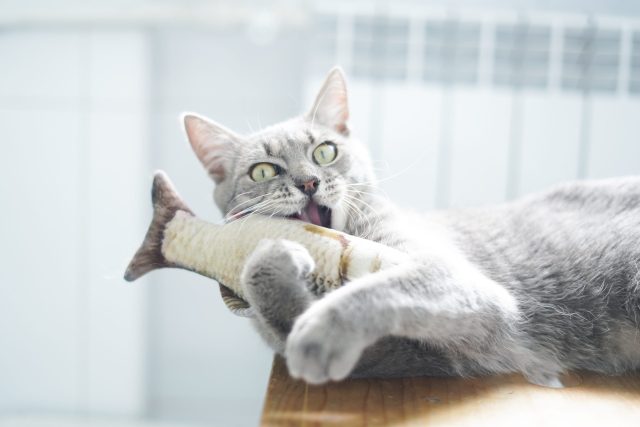
When should I replace cat toys?
Cat toys play a huge part in your kitty’s mental stimulation, physical exercise, and overall happiness. But, over time, toys fall prey to vigorous paws, claws, and teeth, and can wear out, potentially becoming unsafe or uninteresting to your cat. Knowing when to replace them is key to keeping your feline friend engaged and safe.
Signs It’s Time to Replace Cat Toys
- Wear and Tear: Frayed strings, torn fabric, or bite marks can make toys unsafe. Small parts can pose choking hazards, while sharp edges can cause injury.
- Lack of Interest: If your cat no longer shows interest in a toy they once loved, it might be due to wear and tear or simply boredom. Introducing new toys can rekindle their playfulness.
- Dirty or Soiled Toys: Toys that are heavily soiled and cannot be cleaned should be replaced to prevent bacterial growth and maintain hygiene.
- Damaged Electronic Toys: Electronic toys that no longer function as intended, whether due to battery issues or mechanical faults, should be replaced for safety and enjoyment.
Choosing the Right Replacement Cat Toys
- Safety First: Select toys without small, detachable parts that could be swallowed. Avoid toys with strings, ribbons, or yarn for unsupervised play, as they can pose strangulation hazards.
- Variety and Engagement: Cats enjoy a variety of toys. Include interactive toys, puzzle feeders, balls, and plush toys to keep them mentally and physically stimulated. Check out the 21 Best Cat Toys To Keep Kitties Feeling Frisky and introduce your cat to a whole new level of fun!
- Material Considerations: Choose toys made from non-toxic, durable materials that can withstand rough play.
- Cat’s Preference: Observe your cat’s playing style and preferences. Some cats prefer toys that mimic prey, like mice or birds, while others might like crinkly or soft toys.
RELATED: Decoding Feline Predators: Discover & Understand Your Cat’s Prey Preference
Regular Toy Rotation to Keep Interest
Rotating your cat’s toys can keep them interested and engaged. Store away some toys while presenting others, and then swap them after a while. This can make old toys feel new and exciting.
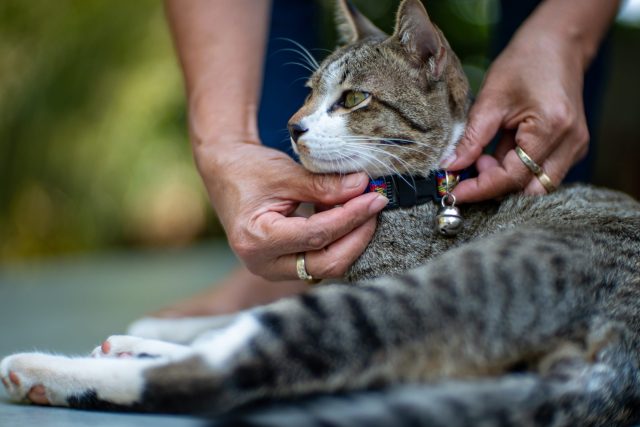
When should I replace cat collars, harnesses, and leashes?
Cat collars, harnesses, and leashes are essential for your cat’s safety for identification purposes and outdoor adventures. It’s important to recognize when these items need replacing to ensure your cat’s safety and comfort. Here’s a brief guide on when and why to replace these items.
When to Replace Cat Collars
- Visible Wear and Tear: Fraying, fading, or signs of damage to the collar material can weaken its integrity, making it less secure.
- Faulty Clasps: If the clasps are no longer fastening securely or are damaged, it’s time to replace your cat’s collar.
- Size Adjustments: As cats grow from kittenhood or change in weight, their collar size may need updating to ensure a comfortable and safe fit.
When to Replace Harnesses and Leashes
- Signs of Strain: Look for stretching, fraying, or tearing, especially near the leash clasp and harness straps, which could compromise safety.
- Material Degradation: If the material has become stiff, brittle, or otherwise compromised, it can be uncomfortable and less durable for your cat.
- Hardware Issues: Replace if the leash snap or harness buckles are not functioning smoothly, as they are critical for secure attachment.
Choosing the Right Replacement
Take care in choosing a safe breakaway cat collar as collars with buckles or made from elastic can prove dangerous to cats.
- Fit and Comfort: Ensure collars, harnesses, and leashes fit well without causing discomfort. There should be enough room to fit two fingers between the collar/harness and your cat’s body.
- Reflective and Breakaway Features: For collars, consider breakaway designs for safety. Reflective materials are useful for visibility during nighttime walks. Choose one of the 10 Best Breakaway Cat Collars For Quick Release Action & Safety.
- Quality Materials: Durable materials like nylon or leather ensure longevity and comfort.
- Appropriate Style: Choose styles that suit your cat’s size and temperament. Some cats may prefer lightweight collars, while others might need sturdier harnesses for secure handling.
Collars, leashes, and harnesses are not just accessories; they play a pivotal role in your cat’s safety when outdoors. A well-fitting, comfortable, and secure collar or harness can make all the difference in ensuring enjoyable and safe outings with your feline friend.

When should I replace cat grooming tools?
Proper grooming is part of healthy cat care, and the tools you use play a significant role in this routine. Over time, grooming tools can become worn out or less effective, making them less safe or comfortable for your cat. Knowing when to replace these tools ensures a pleasant and effective grooming experience for both you and your pet. Here’s what to consider:
When to Replace Grooming Brushes and Combs
- Bristle Wear: If the bristles on brushes become bent, broken, or fall out, they’re less effective and could potentially scratch your cat’s skin.
- Handle Damage: A damaged or broken handle can make the tool difficult to use and control, which might lead to accidental injury.
- Rust or Corrosion: Metal components, like those on combs or de-shedding tools, can rust or corrode over time, which can be harmful to your cat’s skin and coat.
- Cleaning Inefficiency: If tools are no longer getting clean despite thorough washing, it’s time for a replacement to maintain hygiene.
When to Replace Cat Nail Clippers
- Dull Blades: Dull blades can cause splitting or crushing of the nail instead of a clean cut, which can be painful and harmful to your cat.
- Damaged Mechanisms: If the clipper’s mechanism is not functioning smoothly, it can make nail trimming difficult and unsafe.
RELATED: What To Know About Clipping Your Cat’s Nails
Choosing the Right Grooming Tool Replacements
- Tool Type: Choose the right type of brush or comb based on your cat’s coat type. For instance, a slicker brush is great for long-haired cats, while a fine-toothed comb might be better for short-haired breeds. The itPlus Self-Cleaning Cat Grooming Brush is a handy option that cleans out with the easy push of a button.
- Ergonomic Design: Tools with ergonomic designs are easier to handle and provide a more comfortable grooming experience for both you and your cat.
- Quality Materials: High-quality materials ensure durability and safety. Stainless steel is a good option for metal parts, while natural bristles can be gentler on your cat’s skin.
- Safe Nail Clippers: For nail clippers, ensure they are specifically designed for cats. A safety stop feature can prevent over-trimming. In addition to a new set of cat nail trimmers, these three tips for clipping cat nails can make the job an easier endeavor.
Using the right, well-maintained tools not only makes grooming more pleasant, but also promotes your cat’s health by preventing skin irritation and coat issues.
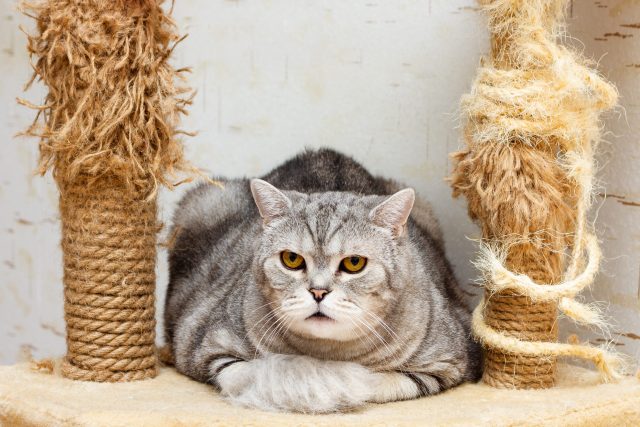
Cats Have Lots of Stuff! Keep It All Maintained
In wrapping up our guide on replacing your cat’s gear, it’s clear that the journey of feline companionship goes beyond mere ownership. It’s about creating a nurturing environment, understanding your cat’s needs, and ensuring their safety, comfort, and happiness through every stage of their life. Regular inspection and timely replacement of your cat’s items are not just chores; they are acts of love and care that speak volumes about your bond. Whether it’s the soft embrace of a new bed, the intrigue of a fresh toy, or the safety of a well-fitted collar, each replaced item enhances your cat’s quality of life.

